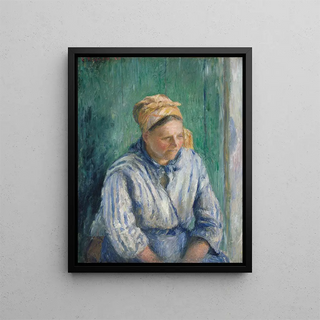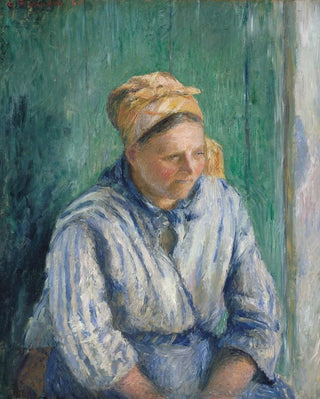Art print | Study of the laundress - Camille Pissarro


View from behind

Frame (optional)
Camille Pissarro's artwork "Study of the Laundress" is a true ode to everyday life, capturing the very essence of a moment frozen in time. In this canvas, the artist invites us to delve into the world of laundresses, these hardworking women who labor with dedication. Pissarro, an iconic figure of Impressionism, manages to immortalize a mundane moment, transforming it into a scene imbued with poetry. The light dancing on the hanging clothes, the fluid movements of the laundress—all contribute to creating a vibrant and lively atmosphere. This painting, much more than a simple representation, is an open window to an era and an activity often forgotten.
Style and uniqueness of the work
Pissarro's style is distinguished by his ability to capture light and color in a striking manner. In "Study of the Laundress," quick and delicate brushstrokes evoke a sense of movement and life. The pastel shades, blending hues of blue, white, and beige, harmonize seamlessly, imparting a softness and warmth to the scene. The artist employs plein air techniques, allowing natural elements to influence his palette and approach. This work is also characterized by a balanced composition, where the central figure of the laundress is surrounded by an environment that enriches the visual narrative. The apparent simplicity of the scene conceals, in reality, emotional depth, paying homage to the dignity of daily work.
The artist and his influence
Camille Pissarro, born in 1830, is often regarded as the father of Impressionism. His artistic journey is marked by an relentless quest for truth and beauty in everyday life. Pissarro was able to influence many artists of his time, notably through his commitment to painting scenes of rural and urban life. His innovative approach, which favors direct observation of nature and human beings, paved the way for new perspectives in the art world. By incorporating social themes and highlighting the lives of working classes, he contributed to transforming the way art was perceived, making it accessible and

Matte finish

View from behind

Frame (optional)
Camille Pissarro's artwork "Study of the Laundress" is a true ode to everyday life, capturing the very essence of a moment frozen in time. In this canvas, the artist invites us to delve into the world of laundresses, these hardworking women who labor with dedication. Pissarro, an iconic figure of Impressionism, manages to immortalize a mundane moment, transforming it into a scene imbued with poetry. The light dancing on the hanging clothes, the fluid movements of the laundress—all contribute to creating a vibrant and lively atmosphere. This painting, much more than a simple representation, is an open window to an era and an activity often forgotten.
Style and uniqueness of the work
Pissarro's style is distinguished by his ability to capture light and color in a striking manner. In "Study of the Laundress," quick and delicate brushstrokes evoke a sense of movement and life. The pastel shades, blending hues of blue, white, and beige, harmonize seamlessly, imparting a softness and warmth to the scene. The artist employs plein air techniques, allowing natural elements to influence his palette and approach. This work is also characterized by a balanced composition, where the central figure of the laundress is surrounded by an environment that enriches the visual narrative. The apparent simplicity of the scene conceals, in reality, emotional depth, paying homage to the dignity of daily work.
The artist and his influence
Camille Pissarro, born in 1830, is often regarded as the father of Impressionism. His artistic journey is marked by an relentless quest for truth and beauty in everyday life. Pissarro was able to influence many artists of his time, notably through his commitment to painting scenes of rural and urban life. His innovative approach, which favors direct observation of nature and human beings, paved the way for new perspectives in the art world. By incorporating social themes and highlighting the lives of working classes, he contributed to transforming the way art was perceived, making it accessible and






